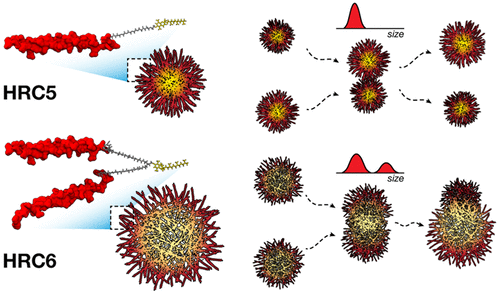Our official English website, www.x-mol.net, welcomes your feedback! (Note: you will need to create a separate account there.)
Structure–Stability–Function Mechanistic Links in the Anti-Measles Virus Action of Tocopherol-Derivatized Peptide Nanoparticles
ACS Nano ( IF 17.1 ) Pub Date : 2018-09-19 00:00:00 , DOI: 10.1021/acsnano.8b01422 Tiago N. Figueira 1 , Diogo A. Mendonça 1 , Diana Gaspar 1 , Manuel N. Melo 2 , Anne Moscona 3, 4, 5, 6 , Matteo Porotto 3, 4, 7 , Miguel A. R. B. Castanho 1 , Ana Salomé Veiga 1
ACS Nano ( IF 17.1 ) Pub Date : 2018-09-19 00:00:00 , DOI: 10.1021/acsnano.8b01422 Tiago N. Figueira 1 , Diogo A. Mendonça 1 , Diana Gaspar 1 , Manuel N. Melo 2 , Anne Moscona 3, 4, 5, 6 , Matteo Porotto 3, 4, 7 , Miguel A. R. B. Castanho 1 , Ana Salomé Veiga 1
Affiliation

|
Measles remains one of the leading causes of child mortality worldwide and is re-emerging in some countries due to poor vaccine coverage, concomitant with importation of measles virus (MV) from endemic areas. The lack of specific chemotherapy contributes to negative outcomes, especially in infants or immunodeficient individuals. Fusion inhibitor peptides derived from the MV Fusion protein C-terminal Heptad Repeat (HRC) targeting MV envelope fusion glycoproteins block infection at the stage of entry into host cells, thus preventing viral multiplication. To improve efficacy of such entry inhibitors, we have modified a HRC peptide inhibitor by introducing properties of self-assembly into nanoparticles (NP) and higher affinity for both viral and cell membranes. Modification of the peptide consisted of covalent grafting with tocopherol to increase amphipathicity and lipophilicity (HRC5). One additional peptide inhibitor consisting of a peptide dimer grafted to tocopherol was also used (HRC6). Spectroscopic, imaging, and simulation techniques were used to characterize the NP and explore the molecular basis for their antiviral efficacy. HRC5 forms micellar stable NP while HRC6 aggregates into amorphous, loose, unstable NP. Interpeptide cluster bridging governs NP assembly into dynamic metastable states. The results are consistent with the conclusion that the improved efficacy of HRC6 relative to HRC5 can be attributed to NP instability, which leads to more extensive partition to target membranes and binding to viral target proteins.
中文翻译:

生育酚衍生肽纳米颗粒的抗麻疹病毒作用中的结构-稳定性-功能机制链接。
麻疹仍然是世界范围内导致儿童死亡的主要原因之一,并且由于疫苗覆盖率不高以及从流行地区进口麻疹病毒(MV),麻疹在一些国家正在重新出现。缺乏特异性化学疗法会导致不良结果,尤其是在婴儿或免疫缺陷的个体中。靶向MV包膜融合糖蛋白的MV融合蛋白C端七肽重复序列(HRC)衍生的融合抑制剂肽在进入宿主细胞的阶段阻止了感染,从而阻止了病毒的繁殖。为了提高此类进入抑制剂的功效,我们通过将自组装特性引入纳米颗粒(NP)以及对病毒和细胞膜均具有更高的亲和力,对HRC肽抑制剂进行了改良。肽的修饰包括与生育酚共价接枝以增加两亲性和亲脂性(HRC5)。还使用了另一种由接枝到生育酚的肽二聚体组成的肽抑制剂(HRC6)。光谱,成像和模拟技术用于表征NP,并探索其抗病毒功效的分子基础。HRC5形成胶束稳定的NP,而HRC6聚集成无定形,松散,不稳定的NP。肽间簇桥接控制NP组装成动态的亚稳态。该结果与以下结论一致:相对于HRC5,HRC6的功效提高可归因于NP不稳定性,从而导致更广泛地分配至靶膜并与病毒靶蛋白结合。还使用了另一种由接枝到生育酚的肽二聚体组成的肽抑制剂(HRC6)。光谱,成像和模拟技术用于表征NP,并探索其抗病毒功效的分子基础。HRC5形成胶束稳定的NP,而HRC6聚集成无定形,松散,不稳定的NP。肽间簇桥接控制NP组装成动态的亚稳态。该结果与以下结论一致:相对于HRC5,HRC6的功效提高可归因于NP不稳定性,从而导致更广泛地分配至靶膜并与病毒靶蛋白结合。还使用了另一种由接枝到生育酚的肽二聚体组成的肽抑制剂(HRC6)。光谱,成像和模拟技术用于表征NP,并探索其抗病毒功效的分子基础。HRC5形成胶束稳定的NP,而HRC6聚集成无定形,松散,不稳定的NP。肽间簇桥接控制NP组装成动态的亚稳态。该结果与以下结论一致:相对于HRC5,HRC6的功效提高可归因于NP不稳定性,从而导致更广泛地分配至靶膜并与病毒靶蛋白结合。并使用模拟技术来表征NP,并探索其抗病毒功效的分子基础。HRC5形成胶束稳定的NP,而HRC6聚集成无定形,松散,不稳定的NP。肽间簇桥接控制NP组装成动态的亚稳态。该结果与以下结论一致:相对于HRC5,HRC6的功效提高可归因于NP不稳定性,从而导致更广泛地分配至靶膜并与病毒靶蛋白结合。并使用模拟技术来表征NP,并探索其抗病毒功效的分子基础。HRC5形成胶束稳定的NP,而HRC6聚集成无定形,松散,不稳定的NP。肽间簇桥接控制NP组装成动态的亚稳态。该结果与以下结论一致:相对于HRC5,HRC6的功效提高可归因于NP不稳定性,从而导致更广泛地分配至靶膜并与病毒靶蛋白结合。
更新日期:2018-09-19
中文翻译:

生育酚衍生肽纳米颗粒的抗麻疹病毒作用中的结构-稳定性-功能机制链接。
麻疹仍然是世界范围内导致儿童死亡的主要原因之一,并且由于疫苗覆盖率不高以及从流行地区进口麻疹病毒(MV),麻疹在一些国家正在重新出现。缺乏特异性化学疗法会导致不良结果,尤其是在婴儿或免疫缺陷的个体中。靶向MV包膜融合糖蛋白的MV融合蛋白C端七肽重复序列(HRC)衍生的融合抑制剂肽在进入宿主细胞的阶段阻止了感染,从而阻止了病毒的繁殖。为了提高此类进入抑制剂的功效,我们通过将自组装特性引入纳米颗粒(NP)以及对病毒和细胞膜均具有更高的亲和力,对HRC肽抑制剂进行了改良。肽的修饰包括与生育酚共价接枝以增加两亲性和亲脂性(HRC5)。还使用了另一种由接枝到生育酚的肽二聚体组成的肽抑制剂(HRC6)。光谱,成像和模拟技术用于表征NP,并探索其抗病毒功效的分子基础。HRC5形成胶束稳定的NP,而HRC6聚集成无定形,松散,不稳定的NP。肽间簇桥接控制NP组装成动态的亚稳态。该结果与以下结论一致:相对于HRC5,HRC6的功效提高可归因于NP不稳定性,从而导致更广泛地分配至靶膜并与病毒靶蛋白结合。还使用了另一种由接枝到生育酚的肽二聚体组成的肽抑制剂(HRC6)。光谱,成像和模拟技术用于表征NP,并探索其抗病毒功效的分子基础。HRC5形成胶束稳定的NP,而HRC6聚集成无定形,松散,不稳定的NP。肽间簇桥接控制NP组装成动态的亚稳态。该结果与以下结论一致:相对于HRC5,HRC6的功效提高可归因于NP不稳定性,从而导致更广泛地分配至靶膜并与病毒靶蛋白结合。还使用了另一种由接枝到生育酚的肽二聚体组成的肽抑制剂(HRC6)。光谱,成像和模拟技术用于表征NP,并探索其抗病毒功效的分子基础。HRC5形成胶束稳定的NP,而HRC6聚集成无定形,松散,不稳定的NP。肽间簇桥接控制NP组装成动态的亚稳态。该结果与以下结论一致:相对于HRC5,HRC6的功效提高可归因于NP不稳定性,从而导致更广泛地分配至靶膜并与病毒靶蛋白结合。并使用模拟技术来表征NP,并探索其抗病毒功效的分子基础。HRC5形成胶束稳定的NP,而HRC6聚集成无定形,松散,不稳定的NP。肽间簇桥接控制NP组装成动态的亚稳态。该结果与以下结论一致:相对于HRC5,HRC6的功效提高可归因于NP不稳定性,从而导致更广泛地分配至靶膜并与病毒靶蛋白结合。并使用模拟技术来表征NP,并探索其抗病毒功效的分子基础。HRC5形成胶束稳定的NP,而HRC6聚集成无定形,松散,不稳定的NP。肽间簇桥接控制NP组装成动态的亚稳态。该结果与以下结论一致:相对于HRC5,HRC6的功效提高可归因于NP不稳定性,从而导致更广泛地分配至靶膜并与病毒靶蛋白结合。



























 京公网安备 11010802027423号
京公网安备 11010802027423号